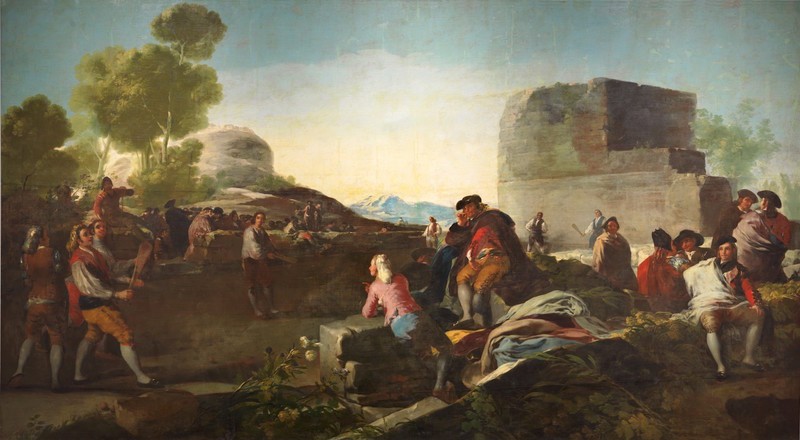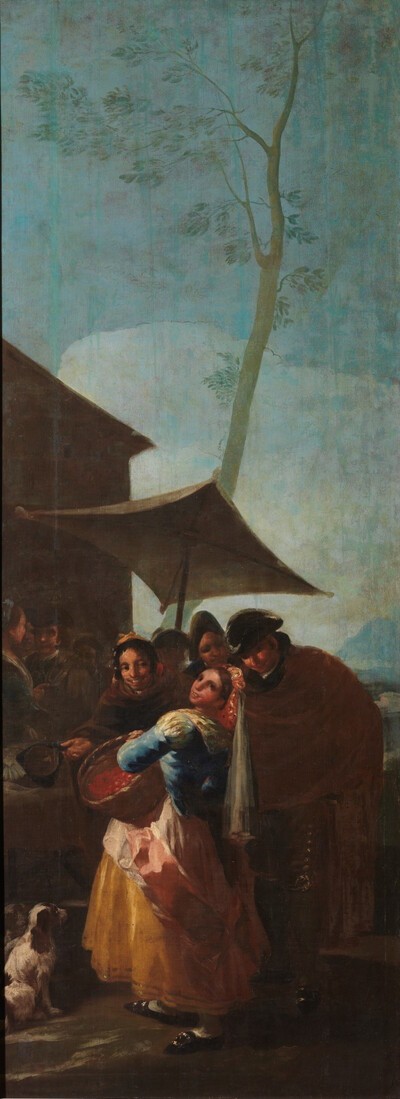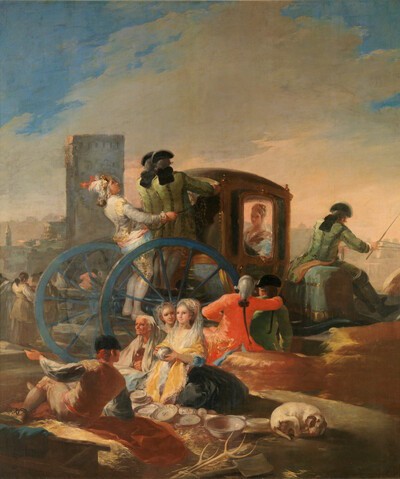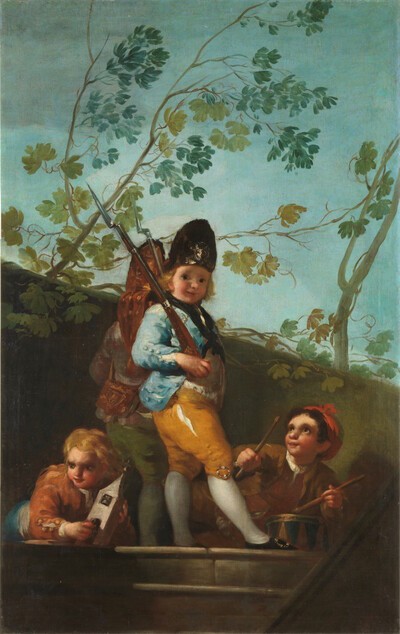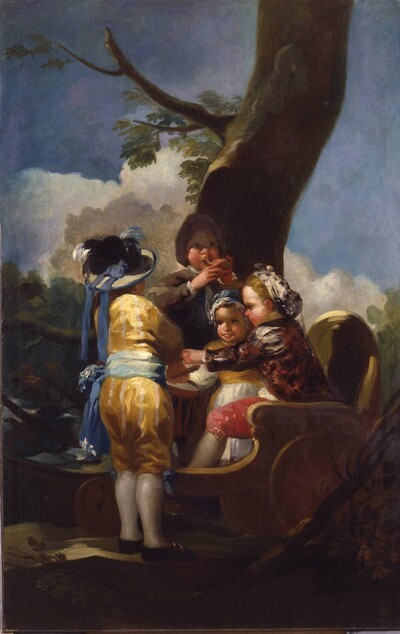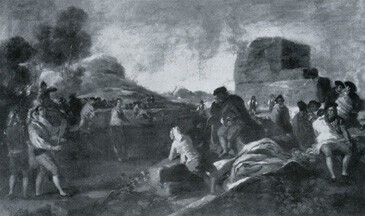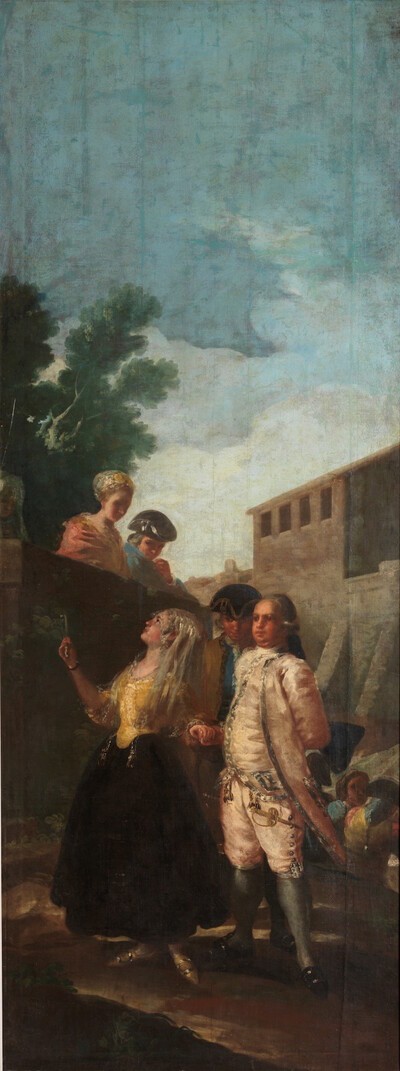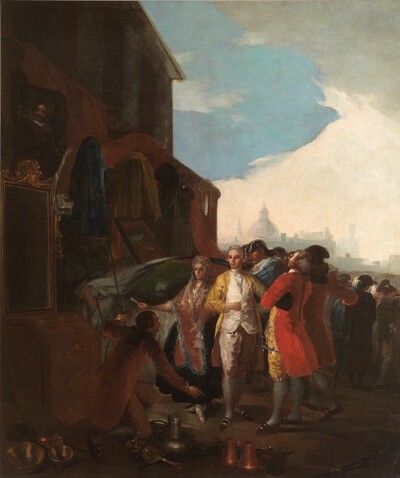- Cronología
- 1779
- Ubicación
- The Prado National Museum. Madrid, Madrid, Spain
- Dimensiones
- 261 x 470 cm
- Técnica y soporte
- Oil on canvas
- Reconocimiento de la autoría de Goya
- Documented work
- Titular
- El Prado National Museum
- Ficha: realización/revisión
- 24 Nov 2009 / 14 Jun 2023
- Inventario
- (P00784)
This work forms part of the series of seven cartoons on the theme of the fair for tapestries designed to decorate the bedroom of the Prince and Princess of Asturias in the palace of El Pardo. The other six cartoons were delivered on 6 January 1779 (see The Fair at Madrid), whilst the invoice for this cartoon, which was made later, was presented on 21 July 1779. A Stickball Game took the place of The Blind Guitarist on the north wall of the bedroom. Initially, the later design was going to form part of this series but ended up being used in the antechamber to the bedroom, instead.
Around 1856 or 1857, the cartoon was moved from the Royal Tapestry Factory of Santa Bárbara to the Royal Palace in Madrid. In 1870, it was taken to the Prado Museum under orders given on 18 January and 9 February.
The composition of this cartoon is in many ways similar to that of Hunting Party, both featuring multiple figures distributed across different planes, from the foreground going back into the background. There is no doubt that Goya's skill in capturing a sense of depth and his use of chiaroscuros had increased by the time he made this painting. Here the composition is much more believable and the space much better defined.
Gudiol points out that there is a possible self-portrait among the depicted figures.
The subject matter of this work, the game, does not appear to be in keeping with the rest of the series for the royal bedroom, which was dedicated to the peoples of Spain and the landscape of Madrid, under the pretext of the city's annual fair. However, it does maintain the optimism of the rest of the cartoons, a faithful reflection of the mood of Goya, who was enjoying a highpoint in his professional life.
The American scholar Janis Tomlinson goes further and suggests that the ball game is a sexual metaphor, justifying this hypothesis by pointing out the double meaning that the word ball can have, the gesture of the central majo figure, who appears to be drawing the viewer's attention to his own "equipment" and the fact that, in the 16th and 17th centuries, this game was in effect regarded as a sexual metaphor.
Cruzada Villaamil has identified the site where the game is being played as the area surrounding the Alameda de Osuna neighbourhood of Madrid, although some authors believe it could be a conventional landscape invented by the artist.
The reddish preparation that Goya applied, sometimes covered with a thin glaze, has caused the work to darken over the years. Its colours now appear flat and lack the tonal range that they would have had originally.
-
Goya. 250 AniversarioMuseo Nacional del PradoMadrid1996consultant editor Juan J. Luna. From March 29th to June 2nd 1996cat. 24
-
Goya en Madrid. Cartones para tapices 1775-1794Museo Nacional del PradoMadrid2014p. 95
-
L'œuvre peint de Goya. 4 volsParís1928-1950vol. I, p. 77 (cat. 18).
-
Tapices de GoyaMadridPatrimonio Nacional1946pp. 112, 229, cat. 27 y láms. 111-117
-
Vie et ouvre de Francisco de GoyaParísOffice du livre1970pp. 76, 89, cat. 130
-
BarcelonaPolígrafa1970vol. I, p. 248, cat. 82
-
L’opera pittorica completa di GoyaMilanRizzoli1974p. 95, cat. 87
-
Francisco de Goya, 4 vols.ZaragozaCaja de Ahorros de Zaragoza, Aragón y Rioja1980-1982vol. I, p. 110 y p. 153 (il.)
-
Imagen de GoyaMadridLumen1983p. 67
-
Francisco de Goya, cartones y tapicescol. col. "Espasa Arte"Espasa Calpe1987pp. 101, 102, 113, 192, 270, cat. 31C y
-
Francisco de Goya. Los cartones para tapices y los comienzos de su carrera en la corte de Madridcol. col. "Ensayos de Arte Cátedra"MadridCátedra1987pp. 120-126 y pp. 120, 121 (ils.)
-
Goya. 250 AniversarioMadridMuseo del Prado1996pp. 304, 305, cat. 24 y pp. 98 y 99 (ils
-
Salas del Palacio Real de El Pardo para las que se tejieron tapices sobre cartones de Francisco de Goya: identificación de las habitaciones y ajuste de las obras de Goya en los alzados de las paredesin HERRERO CARRETERO, Concha (curator, Tapices y cartones de Goya (catalogue of the exhibition organizated at the Palacio Real de Madrid, from may to june 1996)MadridPatrimonio Nacional, Goya 96, Lunwerg1996p. 171 (il.)
-
Goya en Madrid. Cartones para tapices 1775-1794MadridMuseo Nacional del Prado2014p. 95
